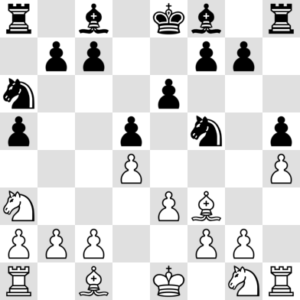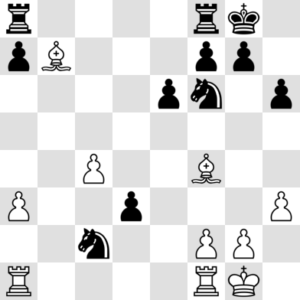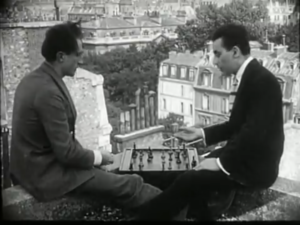Once again we have a novelty on this blog. Not that it is anything at all recent, in fact, our subject today is from all the way back in 1924, but for the first time we see an actual chess expert on film! But perhaps I should tell you a bit about it, because I don’t think Entr’acte is a household name. It is a short film by Frenchman René Clair which was, as the title suggest, meant as a filler between two acts of the long-forgotten ballet Relâche by dadaist painter Picabia and with music by Erik Satie. Usually, when describing a movie, I would talk about the plot, but since there isn’t one I can dispense with that here.
The person on the left here is none other than Marcel Duchamp, world famous for his dadaistic paintings and sculptures — like the infamous fountain — but more deservedly remembered as a decent but far from world-class chess player. The person on the right is Duchamp’s friend Man Ray, a famous dadaist painter and photographer but not known to be at all skilled at chess.
But let’s back up a bit. Before we see the picture above, we were already treated to a nice view of (most of) the board:1
 which seems plausible enough for a game between beginners. The one slightly puzzling thing is how the queens got traded off. Presumably, white played Qf3, black replied Qf6 and after Be2 Qxf3 Bxf3 we got the configuration currently on the board. But then the move count becomes weird: apart from the three moves given, white must have played four more. Black, on the other hand, has played an additional seven moves to the given two moves. Clearly, the count is off. Especially because it turns out that it’s black’s move, as we see him play Nb4.
which seems plausible enough for a game between beginners. The one slightly puzzling thing is how the queens got traded off. Presumably, white played Qf3, black replied Qf6 and after Be2 Qxf3 Bxf3 we got the configuration currently on the board. But then the move count becomes weird: apart from the three moves given, white must have played four more. Black, on the other hand, has played an additional seven moves to the given two moves. Clearly, the count is off. Especially because it turns out that it’s black’s move, as we see him play Nb4.
But, as attentive readers might have noted, none of this seems to match the position in the screenshot I gave: there are far too many pieces for that! Here’s my reconstruction of that position:
 Hey, that seems quite plausible! Perhaps the presence of an actual chess player on set makes itself felt here. The position we saw in close-up was probably not run by Duchamp and is consequently a lot less plausible.
Hey, that seems quite plausible! Perhaps the presence of an actual chess player on set makes itself felt here. The position we saw in close-up was probably not run by Duchamp and is consequently a lot less plausible.
In this one, it seems like black gave up his bishop pair to win a pawn and brashly push it to d3, where it is supporting a — for white — very annoying knight. It is not clear whose move it is, but whatever the case may be, black is better. True, there is an exchange en prise on a8 but on a1, too, so that evens out.
Realism: 3 & 4/5 Neither position is completely implausible, but the one Duchamp and Man Ray cooked up is clearly a step or two ahead of the other one. It doesn’t have the weird queen exchange and the edge pawns’ progress has been much more reasonable.
Probable winner: Duchamp. His position is better and he can actually play.
1. [The pieces’ dance has been choreographed with this editor.] ↩
